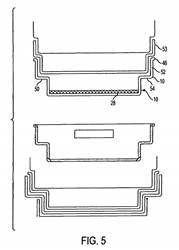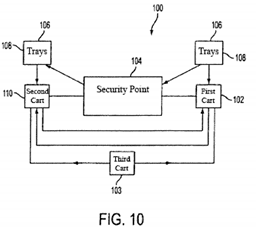Commissioner’s Decision #1377
If you’ve recently passed through airport security in the United States, there is a good chance that the screening procedure you went through, and the tray you put your wallet and keys in to be scanned, was actually patented.
Security Point Media recently obtained approval for a patent on what it calls “Advertising Trays for Security Screening” (Canadian Patent Application No. 2,491,151). As the title suggests, the patent would seem to cover the placement of advertising on security trays. This advertising space is essential to Security Point Media’s business model, whereby the trays are supplied to airports free of charge and revenue is generated by the sale of advertising space on the trays. [78] The invention can be seen in action in this video on the company’s website.
There are however two interesting points about the patent from a legal perspective. First, the patent covers more than just the advertising. It covers a method for moving the trays, which are nested for ease of stacking, around the security checkpoint in an efficient manner using carts. [41] The patent was initially rejected by CIPO for, among other things, obviousness, but evidence showed that this method for moving trays around the security checkpoint unexpectedly and dramatically improved efficiency at security checkpoints, and militated towards overcoming the obviousness hurdle. [70-74] As a result, this case is an excellent example of how innovation, which on hindsight might seem obvious but actually had immense impact on the industry at the time, can be worthy of patenting.
Secondly, the advertising was not considered to be an essential element of the claim that was at issue for obviousness. [24] Therefore this case is also an example of how patenting can protect a valuable business model without the patent actually going to the core of the business model for which protection is sought.
The Invention
The method for moving the security trays around the security checkpoint using carts, along with the idea that the trays are to be nested and are to contain advertising on them, is outlined in claim 1:
- A method comprising
positioning a first tray cart containing a plurality of trays at a proximate end of a scanning device through which objects may be passed, wherein said scanning device comprises said proximate end and a distal end, and said scanning device is located at a security checkpoint,
removing a tray from said first tray cart,
passing said removed tray through said scanning device from said proximate end through to said distal end,
providing a second tray cart at said distal end of said scanning device for
receiving said removed tray,
receiving, from a person, said removed tray passed through said scanning
device in said second tray cart, wherein removed trays passed through said scanning device are nested with each other in said second tray cart, and moving said second tray cart to said proximate end of said scanning device so that trays in said second tray cart can be removed and passed through said scanning device at said proximate end,
wherein said plurality of trays are nestable trays that comprise an interior
bottom surface and sides, wherein said nestable trays each comprise information displayed on said interior bottom surface. [25]
Some representative images include Figures 5 and 10:


The Invention was found to be Nonobvious
After lengthy prosecution, the only issue to be decided at the PAB was the obviousness of claim 1. [15]
The person skilled in the art was taken to be “a person experienced in security checkpoint operations”. [29] This person would possess knowledge of typical security screening procedures, including the use of item trays and carts for transporting passengers’ items, [30] but not the use of nestable trays at a security checkpoint. [33-34]
The problem that the patent addresses is the general difficulty in moving trays through security checkpoints. The current methods (at the time of filing) were inefficient and sometimes caused injury to personnel. [41] The solution is essentially to use nestable trays and to use a system of “first” and “second” carts to transport the trays around the security checkpoint. [42] When broken down, the essential elements claim 1 were taken to be:
(a) the step of positioning of the tray cart containing nested trays at the proximate end of a scanning device at a security checkpoint
(b) the step of passing a tray taken from the tray cart through the scanning device
(c) the subsequent step of, once the scanning process is complete, nesting the used trays on a second cart located at the distal end of the scanning device, and
(d) the step of transporting the second cart with the nested trays back to the proximate end of the scanning device to replenish the tray supply. [45]
Notably, the display of information on the trays was considered non-essential, since it had nothing to do with moving the trays around the checkpoint. [43-44]
When compared to the prior art at the time, the inventive concept of the proposed claim was taken to be all of the essential elements from (a) to (d). [49] The difference between the state of the art and the inventive concept was similarly taken to be all of the essential elements. [59]
The PAB came to its finding that the proposed claim was not obvious based on a number of cumulative factors. [62] First, it was initially counterintuitive in the industry to have “against the stream” movement of loaded tray carts from a secure side of the checkpoint to the non-secure side. [65] Second, although there was a general motivation to solve the well-known efficiency problem of moving trays through the screening process, [76] previous attempts at establishing a more efficient procedure failed. [68] Third, the increase in throughput efficiency that this procedure brought was unexpected. [71] It was only after a demonstration of the method and a pilot program that those skilled in the art recognized its benefit. [70] Fourthly, after having seen the value in the new method, people skilled in the art quickly began adopting the procedure. [73-74]
One caveat to be noted regarding the obviousness analysis was that the PAB thought that the great commercial success of the new method did not necessarily weigh in favour of a finding of non-obviousness. Rather, the PAB was careful to note that the great success might have been due to the very effective business plan of providing the security trays to airports free of charge, rather than due to its inventiveness. [78] Nevertheless, the abundance of factors pointing towards non-obviousness prevailed. [81]
